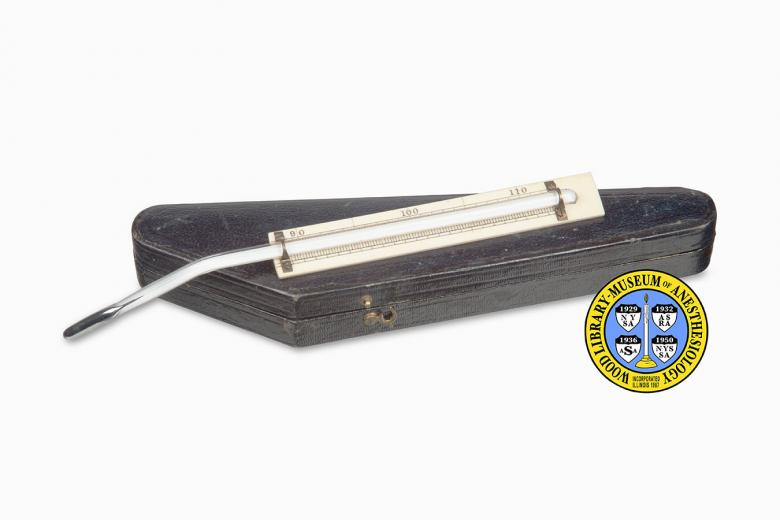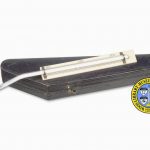Axillary Thermometer
The air in operating rooms is kept cool. Anesthetics can further lower the patient's temperature. Because low body temperature can lead to some medical complications, anesthesiologists monitor this vital sign, and maintain the patient's temperature at the right level. This axillary (underarm) thermometer dates from the late 19th Century, when the recording of vital signs during surgery began. Although slightly less accurate than either oral or rectal thermometers, axillary thermometers provided a convenient way to observe a patient's temperature during surgery, when his mouth would have been covered by an anesthesia mask.
Catalog Record: Axillary Thermometer
Access Key: akhj
Accession No.: 2002-01-30-1 A
Title: [Axilla thermometer.]
Corporate Author: George Tiemann & Co.
Title variation: Alt Title
Title: Axillary thermometer.
Title variation: Alt Title
Title: Underarm thermometer.
Title variation: Alt Title
Title: Clinical thermometer with ivory scale.
Publisher: [New York, NY] : Tiemann & Co., [1860-1890].
Physical Descript: 1 thermometer : glass, ivory, mercury, metal ; 8 cm x 1.5 x 3.8 cm.
Subject: Thermometers.
Subject: Temperature Measurement.
Subject: Monitoring, Intraoperative – instrumentation.
Note Type: General
Notes: Title based on the label for this thermometer in two Tiemann cataloges (1979,
and 1989).
Note Type: With
Notes: With a leather or goatskin covered case the shape of a obtuse triangle. One
side of the case is covered in a paper with a marbled pattern. The case is
held shut with a small latch. The inside of the case is lined with a purple
velvet. The case measures 18.2 cm in length, 4.7 width, and 2.2 cm in depth.
Note Type: Citation
Notes: The American Armamentarium Chirurgicum. New York: George Tiemann & Co.
;1879:80.
Note Type: Citation
Notes: The American Armamentarium Chirurgicum. New York: George Tiemann & Co.;1889:4
Note Type: Citation
Notes: Edmonson JM. American Surgical Instruments: An Illustrated History of Their
Manufacture and a Directory of Instrument Makers to 1900. San Fransisco:
Norman Publishing; 1997:37-53, 70-73, 92-114.
Note Type: Citation
Notes: Wilbur CK. Antique Medical Instruments. Atglen, PA: Schiffer Publishing;
2003:80-82.
Note Type: Citation
Notes: Sessler DI. The Thermoregulation story. Anesthesiology. 2013;118(1):181-186.
Note Type: Physical Description
Notes: One mercury and glass thermometer measuring approximately 17.7 cm when
measured along the length of the thermometer; When measured end to end it is
approximately 17 cm; A scale is etched with black ink along a rectangular
piece of ivory that is attached to the thermometer by two metal bands; The
scale is numbered at “90”, “100”, and “110”; Lines and increment marks
indicated whole and quarter degree increments; The manufacturers name is
marked on the back of the ivory piece as, “G. TIEMANN & Co N.Y”.
Note Type: Reproduction
Notes: Photographed by Mr. Steve Donisch on January 15, 2013.
Note Type: Historical
Notes: Thermometers of this shape were designed to allow the physician to read the temperature while the tip of the thermometer remained in the patient’s axilla (armpit). A temperature scale etched onto a piece of ivory and attached to the glass thermometer, rather than etched directly into the glass, was a common feature of axillary thermometers such as this. This design was common from the mid to late 1800s. The maker of this thermometer George Tiemann & Co. was founded by a German cutler and instrument maker George Tiemann (1793-1868) who immigrated to the U.S. in 1826. The company he built in New York City became one of the leading medical instrument manufacturers in the U.S.
Because a number of factors affect the body’s ability to maintain a normal temperature during anesthesia and surgery, temperature is one of the vital signs that anesthesiologists monitor so that they may detect changes and take appropriate action in a timely manner.
Note Type: Historical
Notes: For a long time it was generally believed that the decrease in temperature that occurred during anesthesia and surgery was of little concern, and little attention was paid to the phenomenon. In the late 1980s and 1990s anesthesiologist Daniel I. Sessler and others turned the understanding of perioperative thermoregulation and hypothermia on its head. Their work changed the understanding of the physiological mechanisms of perioperative hypothermia and the patient care provided to prevent its potentially serious adverse effects.
Note Type: Exhibition
Notes: Displayed in the gallery with “Monitors” from 2002-2007; Selected for the WLM
website.


